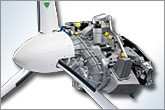Thu, Sep 30, 2010
Milestone Reached In Eight Years Of Production
 Centurion Engines says that their powerplants will achieve a
significant milestone this week. By the end of the third quarter,
the companys says the engines will have logged over 2.5 million
flight hours in GA aircraft and UAV's.
Centurion Engines says that their powerplants will achieve a
significant milestone this week. By the end of the third quarter,
the companys says the engines will have logged over 2.5 million
flight hours in GA aircraft and UAV's.
"Approximately 1.5 million flight hours were logged by the
Centurion 1.7," said Jasper Wolffson, CEO of Centurion. "Its market
launch in 2002 was the catalyst for developing alternative
propulsion systems for small aircraft and UAVs. The successor
models Centurion 2.0 and Centurion 2.0s now being in series
production have logged 1 million flight hours to date. Well over
3,000 Centurion engines have been delivered thus far."
Centurion says it engines have been designed to be installed in
existing cowlings without affecting weight. This allows them to be
used on a wide range of manned and unmanned aircraft. The company
says the technical simplicity of replacing Centurion 1.7's with
Centurion 2.0's on any aircraft is an added advantage.
Both engine models afford above-average reliability, the company
says. According to FAA data, the average for general aviation
in-flight shut downs is one in every 10,000 hours. For Centurion
engines the average failure rate is more than 50 percent lower. The
company says the 2.0 model offers a number of technological
advancements over the 1.7 engine, including a 50 percent longer
time between overhaul, and significant extension of the life of
certain components, such as the clutch and gearbox.

"Centurion engines are future-proof in terms of both economical
as environmental aspects, being able to use standard aviation fuels
like Jet-A instead of having to rely on aviation gasoline (avgas),"
explained Wolffson. Since the engine does not burn avgas,
Centurion says among the "green" benefits of Centurion engines
are no risk of carbon monoxide poisoning, zero lead emissions, and
substantially lower nitrogen and hydrocarbon emissions than with
avgas engines. Plus, Centurion engines are more fuel efficient
across the board, and meet strict noise ordinance
requirements."
More News
Pilot Applied Full Aft Stick And Nose-Up Trim, But The Airplane Remained On The Runway Analysis: The pilot reported that a preflight inspection and flight control checks revealed n>[...]
A Few Questions AND Answers To Help You Get MORE Out of ANN! 1) I forgot my password. How do I find it? 1) Easy... click here and give us your e-mail address--we'll send it to you >[...]
From 2022 (YouTube Edition): Before They’re All Gone... Humankind has been messing about in airplanes for almost 120-years. In that time, thousands of aircraft representing i>[...]
Advanced Air Mobility (AAM) A transportation system that transports people and property by air between two points in the NAS using aircraft with advanced technologies, including el>[...]
Aero Linx: MQ-1B Predator The MQ-1B Predator is an armed, multi-mission, medium-altitude, long-endurance remotely piloted aircraft that is employed primarily as an intelligence-col>[...]
 NTSB Final Report: Douglas A-4K
NTSB Final Report: Douglas A-4K ANN FAQ: Q&A 101
ANN FAQ: Q&A 101 Classic Aero-TV: PBY Catalina--From Wartime to Double Sunrise to the Long Sunset
Classic Aero-TV: PBY Catalina--From Wartime to Double Sunrise to the Long Sunset ANN's Daily Aero-Term (07.01.25): Advanced Air Mobility (AAM)
ANN's Daily Aero-Term (07.01.25): Advanced Air Mobility (AAM) ANN's Daily Aero-Linx (07.01.25)
ANN's Daily Aero-Linx (07.01.25)




